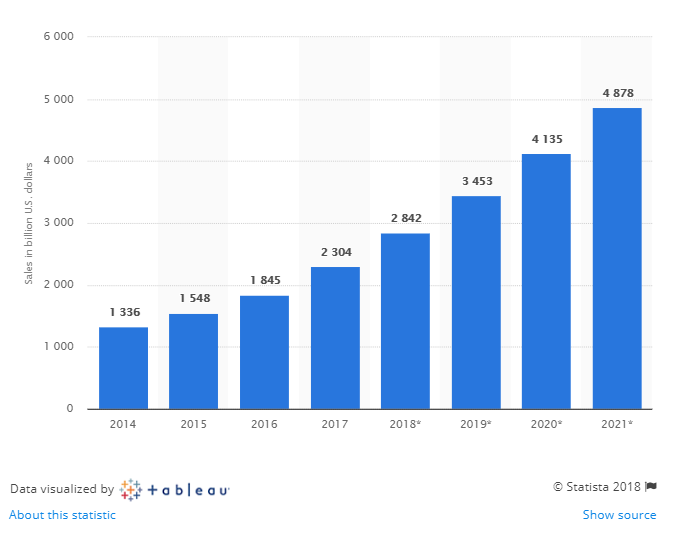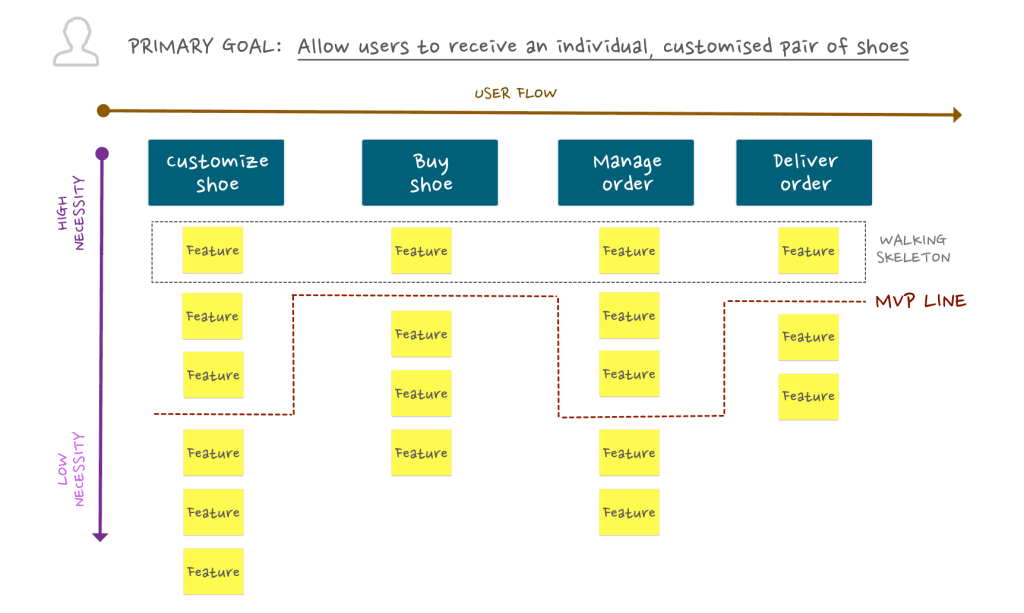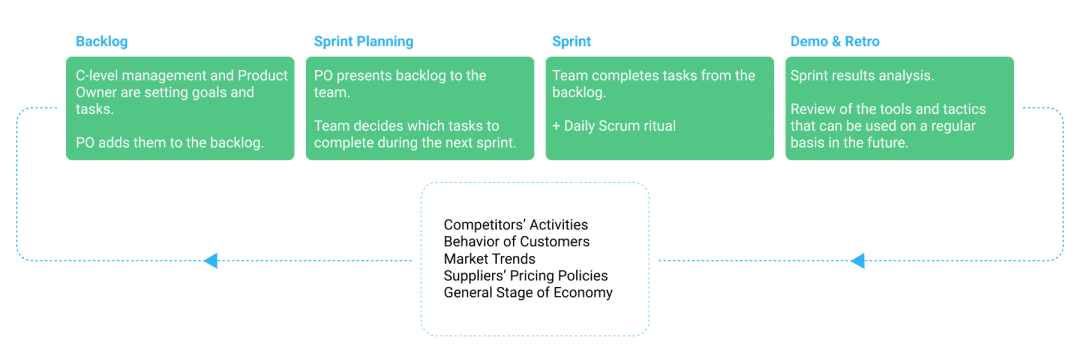Content
How to Plan and Manage E-commerce Projects in 2023

Online retail is a huge and prospective market. In 2023, its value is going to reach $7 trillion. To receive more profit, many offline retailers want to invest in e-commerce development. Nevertheless, without the proper e-commerce processes in place and knowledge of e-commerce project management plans, it is easy to fail before the online store launches.
Lets talk about itHave a project in mind?
We decided to write this article for existing and future clients so they can easily follow the development process. Moreover, knowing the flow of online shop development will help you improve communication with your team and get the most of your collaboration.

Image source: Statista
Why Is It So Hard to Launch an Online Store Without Proper Project Management?
The development of an online store consists of many small processes such as business analysis, choosing the e-commerce platform, UI/UX development, and other. Quite often it is difficult for an online retailer to keep things under control, especially when working with a small team. In order not to fall behind schedule and avoid budget overruns, you need to have a clear strategy for managing your project.
If online shop owners do not plan and manage the development process properly, they can run into some problems. For instance, many online retailers are mostly focused on their business plan rather than on creating an e-commerce website or online platform. For that, they can be unaware of the market situation and the competition, the technical environment, and further tasks they're required to do. Such an attitude results in a lack of vision for the future development of the e-commerce website.
For example, developing an e-commerce website with over 5,000 items in product assortment using a SaaS solution, like WooCommerce, will not get you anywhere. Why? Because website builders provide users with a limited amount of space on their servers. In this case, open-source e-commerce platforms would be the right choice, another way your website will have poor loading speed.
You might also like: Most Promising E-commerce Trends in 2021
Here is what you need to do to manage your e-commerce project effectively.
Choose a project management methodology
A project management methodology is the first step to the success of your e-commerce project plan. The right approach in managing projects enables the team to implement them in the most efficient and effective way while reducing the risks.
Scrum
Our team is e-commerce projects management using Scrum. Ken Schwaber, a software developer, and product manager created this project management methodology to make management of IT projects simpler. This agile methodology allows us to work as a cross-functional unit with self-organization. Through daily communication in the team, we evaluate and adjust the results at each stage of project development. With this approach, we achieve the best quality of the final product. The main Scrum features are:
- A living backlog of prioritized tasks;
- A fixed set of backlog items that get done during sprints;
- A daily team meeting, at which every team member explains their progress on an ongoing task, describes the upcoming work and tells about obstacles;
- Brief sessions of planning the backlog items and defining the sprints;
- Brief retrospectives for all team members to reflect the past sprints.
You may ask what an e-commerce project plan manager does? Remember, there are no project managers in Scrum, only Scrum masters. The primary job of a Scrum Master is similar to e-commerce project manager responsibilities. He or she removes obstacles so the team could deliver the sprint goals in time.
Moreover, Scrum gives the following benefits to the e-commerce business:
- Speed. E-commerce is a fast-developing industry where customer behavior often changes and new technologies appear all the time. Scrum allows the team to achieve quick results and move forward through the development process within a reasonable period.
- Flexibility. Online retail business needs to drive innovations to provide high-value business solutions.
- Collaboration. The development team members have a transparent communication process. During the project, they exchange different ideas to determine new strategies for satisfying users and clients.
Read more: 15 Top Mistakes in E-commerce Retail to Watch Out
The choice of project management methodology is not limited to Scrum, you can also pay attention to the following:
Agile
Agile is also an iterative methodology, but the difference is that some part of the final product is developed at each stage.
The big advantage of this is that customer feedback is received on every feature implemented, which greatly contributes to continuous development.
But keep in mind that this fact can mean that it is harder to predict what the final product will look like if you use this control system.
Kanban
Kanban has a lot in common with Scrum project management methodology, but it is less rigorous. The Kanban PM methodology allows you to categorize tasks as To Do, In Progress, and Done. This technique allows you to make changes not only after the sprint, but also at any time when they are needed.
Kanban is focused on smaller sprints and shorter life cycles. Tasks are usually tracked through a project management application or by moving sticky notes around the board. The main feature of Kanban is regular changes and updates to facilitate the overall progress of the task.
Plan your project wisely
We decided to use the Scrum e-commerce project management approach for several reasons. First, it allows creating a self-organized team. Then, it encourages communication in the team and across development, design, QA and other departments, involved in the development process. It helps us respond to emerging challenges in an agile manner and perform the best results. Below we describe the process of planning an e-commerce project:
Lets talk about itHave a project in mind?
1. Competitor analysis. In the early stages of the project, we conduct in-depth competitor and market research. It helps us to identify the weaknesses and strengths of the market leaders. Moreover, we receive insights on the mistakes we can avoid and the best practices we can adopt.
2. Feature list. This stage includes selecting the features we will integrate into the e-commerce website or the future online platform. The list of features has an impact on the user experience of your future customers.
3. Shipment and payment providers. Our team carefully selects the payment and shipment providers. The choice has a direct impact on the number of future sales, expenses, and the online shop’s trustworthiness.
4. Design. Our team could recommend using some particular layouts or design elements distinguished as your competitor’s best practices. The team also offers several options of themes from websites such as ThemeForest. In addition, we can develop a custom e-commerce design according to your business needs.
5. Data migration. In some cases, a customer already has an online shop with databases to import into the future project. We include the database migration to the workflow since it has an impact on the cost scope and the time of the online shop development.
6. The e-commerce platform. We offer several options of the e-commerce platforms depending on the customer business needs, goals, budget, and other factors. In some cases, we develop custom e-commerce platforms.
Then, to keep the project progress transparent and measurable, we use six main deliverables described below:
- Product vision statement. A quick summary describes the goals of the product.
- Product roadmap. It includes a high-level view of the product requirements that will help us achieve the product vision. At this stage, we also outline a general timeframe of development and release those requirements. The product roadmap further will form the product backlog.
- Product backlog. We create the full list of the tasks in the scope for the e-commerce website, ordered by priority.
- Release plan. It is a high-level timetable for the release of the e-commerce website.
- Sprint backlog. This document includes user stories, the goals, and tasks associated with the current sprint.
- Increment. The working functionality of the product that we demonstrate to a customer at the end of the sprint.

Image source: CayenneApps
Start with an MVP
When our clients send us briefs with the desired functionality they often include too many features. But such features as real-time integration to CRMs, stock control systems, or financial software are not necessary for the initial stages of online shop development. Moreover, building these kinds of features does not make sense even from the client’s perspective. They will increase the cost of initial development but they don't guarantee a return on investment from the e-commerce website.
Instead of building the first version on the online store with complex integrations, we build an MVP. MVP is a minimum viable product, or in other words, the smallest possible representation of a working product. In terms of e-commerce development, it is an online store with basic features.
Developing an online store, especially with custom features, could be risky. To reduce the risks, we create MVP of an online store to receive feedback from customers and online shoppers. We consider all the feedback to improve the design, customer journey, and other online store elements.
But most of all, MVP establishes the principle of continual development.
The scope of an MVP for the e-commerce website depends on the platform, the business goals, and the industry.
In e-commerce, MVP could vary depending on the initial business goals. For one business, MVP could bring profit, while for the other it could be a test of a hypothesis.

Image source: Dinarys
One of our recent projects, launched as MVP, Qlerify a business workflow visualization web app. The app's MVP includes such features as making predictions on football matches, the list of top predictors and their predictions, and calculating your profit according to your predictions.
After the launch, we gathered feedback from users and added other features based on it. In addition, we have also added monetization functionality to the app, since it was the customer's initial business goal.

Image source: Half Pencil
Define a workflow process
When starting each sprint, we have a particular Agile workflow, explained below:
1. Scoping meeting. We organize such meetings with customers to receive answers to questions regarding time estimation, project planning, budgeting, etc.
2. Gather backlog. As we said before, a product backlog includes e-commerce features or user stories we are determined to work on in each sprint.
3. Divide backlog into sprints. To divide complex features into smaller user stories, we consider a full customer journey through the online store. Using such an approach, we make the e-commerce development process faster and easier.
4. Estimate (min-max) tasks from the backlog. When the team is done with the product backlog, we estimate how much time we need to develop each feature. For that, the development and design team members use Fibonacci numbers (1,2,3,5…) to estimate in points the number of development hours required.
5. Weekly with clients and daily with the team. In the daily brief meetings, we share our success and concerns when working on the project. When sharing the status of work, each team member answers three questions on yesterday's tasks, plans for today and informs the Scrum master about the blockers that impede the implementation of the tasks.
6. Working on tasks. Our team works on the current Sprint from the Backlog.
7. End of the weekly status. In the weekly meetings, we share our progress, issues, and the completed tasks. This helps us evaluate our work, performance and eliminate the problems.
8. Deploy to Dev. At this stage, we deploy the ready part of a project to the development environment. It is software used by the development team to conduct changes in the project.
9. Testing. The QA department conducts testing to ensure that the product is bug-free. It is very convenient to detect bugs sprint by sprint.
10. Demo - results of the work on Dev. After finishing each sprint, we conduct meetings with the Product Owner and Scrum Master to discuss all the achieved goals. The Product Owner considers the user stories that each team member implemented and approves or rejects the result.
11. Deploy to production. This is the most exciting part of every project. When all the hard work is done, we deploy the result to production.
12. QA in production. This is a set of techniques used to find out actual issues in the product, receive fast feedback and vital diagnostic data.
13. Monthly (or by call) Retro. In such meetings, the team shares their insights on what they have improved in their performance.

Image source: Medium
Lets talk about itHave a project in mind?
Use team communication software
To keep the different departments of our e-commerce team on the same page, we use different e-commerce project management software, described below. Atlassian Jira This is a popular team collaboration and agile software development tool. Using this program, we plan and track projects and issues. It is a great assistant for delivering projects on time, describing tasks across teams, and prioritizing feature releases. Slack We use this particular chat software to keep the teams in the know, share files, and make calls. It helps us organize chats for specific departments, topics, and projects. What is more convenient, Slack supports integration with Google Drive and Dropbox. This way, we centralize the workflow and keep a feedback loop across resources and teams. Dropbox In Agile teams, file sharing is essential for the simultaneous work of several departments. By using this cloud-based software, our designers and developers share files across teams and gather feedback with comments. Within the Dropbox secure environment, we share the most important files, specification documents, or website prototypes.
Manage time, scope, and budget
As we said before, a website project management plan consists of small tasks and requires the work of many specialists. The main goal of the project manager here is to keep the project on time, on budget, and on the scope. These three parameters are the Project Triangle or Iron Triangle.
The most common issues that occur during the project are schedule delay, cost overrun, and poor quality of the product.
To avoid such issues, our project managers understand how to make all three project constraints adjust to each other and deliver high-quality products. To deliver the projects within the budget and in time, we control human and financial resources, as well as prevent stakeholders from managing project scope. In addition, our project managers keep the team focused and adjust milestones when necessary.
Launch an e-commerce store and keep iterating
After launching the MVP of the e-commerce website, we move to phase two, where we add other features. We also monitor how users interact with the website once it is live. We help our customers to identify problems, run usability tests, and discuss possible solutions.
It is the basic process of continuous development used by many IT companies. During this cycle, the team continues monitoring, experimenting, and building e-commerce websites for the long term.
Conclusion
So, why is project management important in terms of e-commerce development?
Working on the e-commerce project could be chaotic, especially when there are many relevant features to implement. By applying Scrum methodology, we develop successful e-commerce projects. It helps us prioritize the requirements according to the client’s business needs and the performing capacity of the development team. At the initial stage of online store development, we focus on the purchase process and shopper experience. This way, we create a better customer journey, which results in a higher conversion rate of the online store. We keep using Scrum for the development of e-commerce websites since it helps us to keep the process agile and finish projects on time within the customer budget. If this article inspired you to hire us to develop an online store, fill in the contact form below. We are always open for new projects and ready to help, feel free to contact us!
Lassen Sie Profis Ihre Herausforderung meistern
Unsere zertifizierten Spezialisten finden die optimale Lösung für Ihr Unternehmen.



